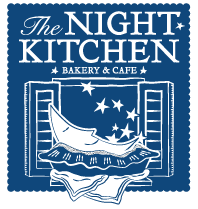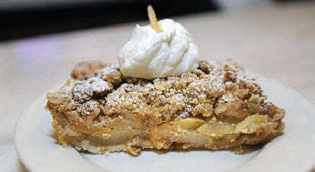The Philadelphia Inquirer
By Elisa Ludwig
There’s no getting around pie, not at this time of year. No matter how innovative our kitchens, there’s always going to be a mandate for pumpkin, a demand for apple, an insistence on pecan, especially on the Thanksgiving table. “It’s just a traditional thing. Most people love the idea of a warm dessert, especially when it’s served with ice cream,” says Amy Edelman, owner of Night Kitchen Bakery in Chestnut Hill, which sells pies five days a week in the lead-up to Thanksgiving. “I’m always surprised at the number of people who show up the day after Thanksgiving for pie – I guess they want it to go with their leftovers.” Yet because of the labor and cost involved, many bakeries don’t make pies from scratch, says Sandy Stauffer, owner of Bakery House in Bryn Mawr. “With cake batter, you can make pounds of batter all at once. You can’t make 100 batches of pie dough at once if you’re using a pastry blender or even a food processor. We usually make eight at a time. And that doesn’t even include peeling and slicing the fruit.” Stauffer says it takes round-the-clock baking, from Monday through Wednesday night, to accommodate holiday orders – approximately 1,500 pies. Of course there are many bakeries, Stauffer points out, that buy frozen and simply pop them in the oven. Others use prefab shells and canned fruit fillings. That’s fine if the baseline is the frozen foods aisle, but by design, pies are meant to be fresh and seasonal, and by the laws of nostalgia, they should be made by someone who really cares.
While food writers in New York and Los Angeles have been celebrating pies as the next big thing, the cupcake remains the popular kid in the Philadelphia dessert class, holding on by the skin of its buttercream frosting.
But Magpie, an artisan shop on South Street that sells seasonal pies by the slice (whole pies are available with 48 hours’ notice), is banking on a pastry turnaround, especially given the fact that quality pie is still an uncommon retail commodity. “It started for me when my neighbor said, ‘Pie is one of my favorite things but you really don’t see it around that much anymore,’ ” says Holly Ricciardi, the Art Institute-trained pastry chef who opened Magpie last summer. “I researched and found that pie shops were opening up in New York and Chicago and other places, so I thought the time was right here.” So far, memories of Grandma’s pies are outpacing the inventive. While the Butterscotch Bourbon outsells the Shoo-Fly, the straight-up Apple Caramel is a big seller. “Mostly, the people who come to the shop have always loved pie but because it’s time-consuming and intimidating they don’t want to waste the effort and risk making a flop at home,” Ricciardi says. Indeed, otherwise courageous bakers tend to crumble like buttery crust in front of a rolling pin.
“People just have trouble with pie dough. I’ve been a baker for 12 years and it probably wasn’t until 11 years in that I finally felt like I got it right,” Edelman says. There’s a lot of decision-making involved: What kind of fat? Egg or vinegar? Blind-bake or single bake? Glaze or not? Double crust or crumb? Recipe alternatives abound, for hand pies, pies in jars, pie-flavored shooters, cakes with pie-ish layers – clever workarounds that can approximate the taste and texture of crust and filling while lowering the level of difficulty. Yet purists will always want the real deal. But experts say if the dough is well made, rolling and shaping shouldn’t be a problem. And no matter what fat you use, it should always be very cold.
While Edelman, after years of experimentation, has strong convictions about an all-butter crust, sacrificing a bit of flakiness for the crunchier texture, Ricciardi and Stauffer feel fine about using shortening. Then there’s lard, which is exceedingly easy to work with, and produces a tender yet flaky product, but is not for vegetarians. There are some basic rules for crustmaking: Chill the dough in a disk shape tightly covered in plastic wrap until it’s ready to roll out. Use a smooth, lightly floured surface. When in doubt, a couple sheets of parchment paper sandwiching the disk can make it easier to move around. Observe the quarter-turn method: Roll from the center to the outer edges, maintaining even pressure, then rotating the dough a quarter-turn until the circle is the needed size. (It should be an inch or two larger than the pan’s circumference.) “Be firm but gentle,” Ricciardi says. “Don’t let it bully you.”
To transfer the dough, loosely roll it over the rolling pin (discarding the parchment paper if using), center it over the pie pan and unroll it, gently pressing it into the bottom and sides. And never, never, never overwork the dough. Here’s the harsh, unforgiving truth about pie dough: if it tears or falls apart, it cannot be balled and rerolled. “The best way to practice is by using Christmas cookie dough,” Stauffer says. “But you can reroll that if you need to.” When prebaking, line the dough with parchment and fill the pie pan to the brim with pie weights or dried beans. (It’s important to fill it completely, or the dough might still shrink.) Bake for 20 minutes, then remove the weights and continue baking for five more minutes. Cool crust completely before adding filling. (Edelman says that when you use butter and mix the fats in more thoroughly, instead of leaving pockets, there’s no need for blind baking because the dough won’t shrink.) The filling should always be seasonal – and this time of year, pumpkin, apple, sweet potato, and pecan remain supreme – but there’s room for innovation without upsetting the pie cart. Ricciardi’s favorite is an oatmeal ginger pear pie, which she says is a lighter, brighter alternative to most fruit concoctions, and can be a great way to finish a heavy Thanksgiving meal.
spacer


